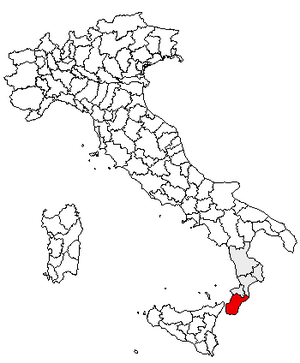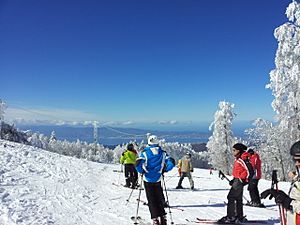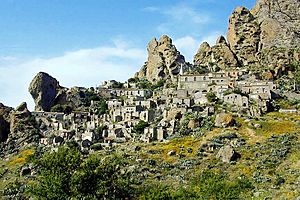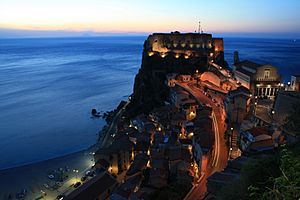Province of Reggio Calabria facts for kids
Quick facts for kids
Province of Reggio Calabria
Reggio Calabria
|
|
|---|---|
 |
|
| Country | |
| Region | Calabria |
| Capital | Reggio Calabria |
| Area | |
| • Total | 3,183 km2 (1,229 sq mi) |
| Population
(2005)
|
|
| • Total | 565,866 |
| • Density | 178/km2 (460/sq mi) |
| Postal Code |
89010-89018, 89020-89036, 89039-89050, 89052, 89054, 89056-89058, 89060, 89063-89065, 89069
|
| Telephone prefix |
0964, 0965, 0966
|
| ISTAT | 080 |
| Vehicle registration | RC |
| No. of communes | 97 |
The Province of Reggio Calabria (which in Italian is Provincia di Reggio Calabria) is a province located in the Calabria region of Italy. It is the southernmost province on the Italian mainland. The Strait of Messina separates it from the island of Sicily. The Aspromonte mountains cover the western part of the province. With its long coastline, this area is a popular place for tourists to visit in the summer. The main city and capital is Reggio.
This province will be replaced by the Metropolitan City of Reggio Calabria starting in 2018.
Contents
Geography of Reggio Calabria
The province of Reggio Calabria is at the very southern tip of mainland Italy. To its west is the Tyrrhenian Sea. To the south and southeast, you'll find the Ionian Sea. Its land borders are quite short. To the northeast is the province of Catanzaro, and to the northwest is the province of Vibo Valentia. The island of Sicily is just about 3 kilometers (2 miles) away across the Strait of Messina.

The land in the province has three main types. Near the west, it is very mountainous. The Aspromonte mountains are made of layers of rock. The highest point is about 1,956 meters (6,417 feet) high. This area is part of the Aspromonte National Park. Many rivers and streams flow from these mountains, but they often dry up in summer. The biggest ones are the Amendolea and the Calopinace.
Lower down, the hills are shaped into terraces. Farmers use these terraces to grow citrus fruits, olives, and grapes. Higher up, the areas are covered with forests. You can find chestnut, beech, and pine trees there. The southern part of the province has a flat coastal area. To the east of the mountains, there is a flat plateau. This plateau stretches from the Tyrrhenian Sea to the Ionian Sea.
History of Reggio Calabria
The Ancient Greeks built a town called "Rhegion" where Reggio is today. This was a very important spot next to the Strait of Messina. The city's museum, the Museo Nazionale, has two famous bronze statues. These are called the Riace bronzes. They were found in the sea near Riace, about 80 kilometers (50 miles) to the east.
Around the 3rd century BC, tribes from the north, like the Samnites, took control. They ruled over what is now Calabria. They also built new cities, including their capital "Consentia," which is now Cosenza. After the Pyrrhic War (280–275 BC), Rome took over Calabria. It stayed under Roman control until the 5th century AD.
In 1908, the city of Reggio and other parts of the province suffered greatly. A huge 1908 Messina earthquake hit the area. This was followed by several tsunamis, which caused even more damage.
In the 1950s, many people from Reggio Calabria and other southern Italian provinces moved away. They went to cities like Rome, Milan, and especially Turin in the north. They left because of poverty and a lack of jobs. The soil in their home region was also not very good for farming. They hoped to find better work in places with stronger economies.
Between 1969 and 1973, there was a period of public protest in southern Italy. People were unhappy about not having enough jobs and poor living conditions. In 1970, Catanzaro was chosen as the location for a new regional government. Both Catanzaro and Reggio Calabria were among the poorer cities in southern Italy. The people of Reggio really wanted their city to be chosen. This led to many protests. People went on strike and held demonstrations for over a year. Sometimes, the police had to step in to control the crowds. Services like the railway from Sicily were stopped. People also occupied the airport, post offices, and TV station at different times.
The Italian government responded to these events. They confirmed Catanzaro as the main regional capital. However, they arranged for the regional assembly to meet in Reggio. They also announced plans for a new port and a steel works in Gioia Tauro. This was meant to create jobs in the area. But before the steel works could be finished, the price of steel dropped. So, the steel works project was stopped. The port, however, was built. Another project, a new power station, did not happen because of environmental concerns. The port has since become a very busy place. It handles over three million shipping containers each year. New roads have also been built to manage all the extra traffic.
Economy of Reggio Calabria
The Reggio Calabria region is very famous for growing the Bergamot orange. Most of these special oranges come from a small area along the Ionian coast of the province. The temperature there is just right for them. The Bergamot orange is so important that it has become a symbol of the entire region. While it's mostly grown here, you can also find it in France, Argentina, Brazil, Turkey, and the US state of Georgia.
Clementines are also grown in a very fertile area called Piana di Gioia Tauro. This area is also used to grow other citrus fruits and olive trees. A big part of the local economy involves making olive oil and processing citrus products.
| Provinces of Calabria |
|---|
| Catanzaro | Cosenza | Crotone | Reggio Calabria | Vibo Valentia |
See also
 In Spanish: Provincia de Regio de Calabria para niños
In Spanish: Provincia de Regio de Calabria para niños



